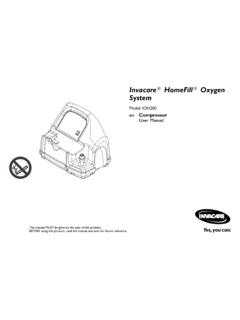Transcription of Module7 BuildingLeadershipSkills - EngenderHealth
1 Mo dule 7 Bui ld in g Le ade rshipSkillsAC QU IR E Pr oje ct/Eng ende rHealthFacilitativeSupe rvision Curriculum Trainer sManual7-1Es senti al Ide as to Convey A l ea deris som eone w ho i nflue nces and gu ides others toward the accomplishment of ago al . Lea ders hi pqual itie s i nclu de the ab ility to inspire others, establish trust, and promote team-wor k. Managingrefers to over seei ng syste ms an d processes, focusi ng on doing things correctly,usi ng r eso urce s w ise ly. A mi ss ionis a st atem ent th at su mmarizes a n organization s purpose and provides therat iona le fo r def ining g oals an d obj ective s. A vi sionis an imag e of h ope, something yo u tru ly wish to create.
2 Management Sciences for Health. 2005. Managers who lead: A handbook for improving health Trustis t he know ledge that anothe r pe rso n will not take advantage of you, which a llows youto f eel saf e put ting yo ur sel f-est ee m an d po sition in that p erson s hands. Wo rk cl imat eis the pr evai lin g wor kplace a tmo sphere as experien ced by employees. It iswha t it fee ls like to w or k i n a pla ce. Thre e key dim ensi ons of work cli ma teare cla rity, challenge, an d support. To l ea d s ta ff thr ough change(i .e. , to implement ne w practices) takes effort. Su ccessf ul sup ervi sor s l ead their st aff through five phases:1. Reco gn izin g a chall enge2.
3 Id ent ify ing pr om isi ng pr actices3. Ad apt ing and t esti ng one prom isi ng p ra ctice o r set of practices4. Imp lement ing the new p racti ce( s)5. Sca ling up t he su ccessful new pr actice (s)Management Sciences for Health. 2004. Management strategies for improving health services. The Manager, 13(3). In its esse nce, leader shi p is a li fe styl e, n ot a p osition. John Hawkins, founder and president, Leadership Edge 2Fa ci lita ti ve S upe rvision Curriculum Traine r s ManualACQUIRE Project/EngenderHealthSe ss io n 7- 1 Leadership StylesObj ecti vesBy the end of thi s session, the parti ci pa nts will be able to: Descr ibe who people ca n c al l a le ader and what qualities make him or her a leader Analyze diffe rent l eaders hip style s Li st and describe lea der ship com pe tencie sMat eri als Resource: L ea dership Style s, Partici pa nt Handbook, page 47 Par tic ip ant H andout : Leader shi p Competencies Par tic ip ant H andout : Exer cise : What Leadership Style Would You Recomme nd?
4 Fl ipchart pa per and mark ers Fl ipchart 7A: L eader ship StyleAd vance Prepar ati on1. Make enough copies of the handout s f or distribution to all partici Prepare Flipchart 7A:AC QU IR E Pr oje ct/Eng ende rHealthFacilitative Supervision Curriculum Trainer s Manual7-3Fl ipchart 7 ALea ders hip Styl eDelegatin gDem ocr at icConsens us-or iente dAut hor itar ianwith som e inp utAu tho rit ar ianLevel of OwnershipLevel of InvolvementSession Time1 hourTrai ni ng Ac ti vi ti es.. ini tion o f a lead er and l ea der ship .. 15 ader shi p st yle s .. 45 io n 7 Detailed StepsAct ivi ty A : D efi nit ion of a Leader and Leadership: Discussion/Presentation (15min utes)1.
5 Present t he lear ning objectives f or this As k t he part ic ipa nts to desc ribe someone who they know and who they call a leader, and invite t hem t o descr ibe why the y can call that person a leader .3. As k t he parti ci pants to define what/ who is a leader and what is le adership, and havethe m describe what lea de rship quali tie s Af ter the participan ts answer, exp lain that a leader is someone who influences andguides others toward the accomplishment of a goal. Leader ship qualities include theabi li ty t o i nspire others, esta bli sh trust, and pr omote teamwork. Tel l t he partici pants thatto be abl e t o do so, supervi sor s should have knowledge and skills, and that during thisand follow ing sessions, they themselves will gain such As k the pa rtic ipa nts to explain who is a manager, a supervisor, and a le ader.
6 Explore theide a of formal le aders versus infor ma l leaders. Ask the partic ipants to give examples ofcas es where f ormal a nd infor ma l le ader s were the same person and examples where theywe re Re min d t he particip ant s t hat you h ave already defined sup erv isi on and managemen inforce the message that man ag ementrefers to overseein g s yste ms a nd p rocesses,foc usi ng on doing thi ngs c orre ct lyand using resources Te ll them t hat i n faci lit ative supervision, the supervisor has additional rol es, among themthose of le adership and st af f empo we rment. The facilitative supervisor s immediate goalis t o t eac h other s ho w to undertake t he quality improvement process, wi th the ul timategoal of enabli ng them to provide hi gh-quality services that meet t hei r cl ient s Br ai ns tor m by asking the pa rtic ipants to list the qualities of a le ade r.
7 Writ e their answerson a piece of flipchart pape Te ll the par ti ci pants that le ade rship competencies are specific skills and knowledge thathel p s upervis ors lea d t he sta ff more e ffectively. Distribute Par ti cipant Handout andask th e partici pants to compar e t he contents with the results of t heir br ainstorm and com-me nt on the simi lar it ie s a nd mment t hat supervis ors need to expand their knowledge and s trength en pa rticular skills(leadership, com municat ion, mana gement, technical, etc.) to be be tter able to lead thesta ff. E xp lai n th at duri ng th e course, the participants wil l w ork on de vel opi ng those ll the partic ipa nts that by combini ng good leadership and m anagem ent qualities,supervi sors are able to lea d staf f to do t he right things the right 4Fa ci lita ti ve S upe rvision Curriculum Traine r s ManualACQUIRE Project/EngenderHealthSession 7 Act ivi ty B : L ead ershi p St yles: Presentatio n/Small-Group Exercise (45 minutes)1.
8 As k the parti ci pants to name differ ent leadership styles that they Tel l t he part ic ipa nts that t he y wi ll discuss different leadershi p s tyl es , a nalyzing theiradvant ages a nd disa dv ant ages. Dist ribute the Leadershi p St yles handout from thePa rt icipant Handbook and ask for volunteers to read it row by row. Ask the partic ipantsto com me nt on whethe r they agr ee wit h the definitions and de sc ript ions of eac h st yle andwhethe r t hey would like to add anyt hing else to Te ll the par ti ci pants that during the next exercise, they will decide what le adership stylethe y would recomme nd in thr ee diff er ent Divide the part ic ipa nts into three gr Di st ribute P ar ti cipant H andout and assign one case to each of the Al low five m inutes f or the par tic ipants to discuss the cases in t heir small groups and toma ke a As k a repres ent ative fr om each group to read a situation and to present t he Di sc uss the re sults with the par ti cipants.
9 Tell them that dif fer ent sit uations require apply-ing di ffer ent st yl es of le ader shi p. The use of a leadership style de pends on the t he partici pants will see f rom the e xercise, there are times when decisions should bema de in an authoritar ia n manner. 9. Reveal Flipcha rt 7A and allow th e partici pa nt s a few minute s t o a na lyz e the k f or a volunt eer to comment on it. Tell them that decisions made with the involve-me nt of ot hers general ly result in a higher level of staff ownership and commitment,which in t urn results in a higher c hance of implementation. ll the par ti ci pants that thr ough the following sessions, they wil l work on developingspecific le adershi p s QU IR E Pr oje ct/Eng ende rHealthFacilitative Supervision Curriculum Trainer s Manual7-5 Session 7 Tr ainer s Resou rce: A nsw ers t o Case StudiesSituat ion IDe le ga ti c lini cal direct or should delega te the decision to a small group consistingof me di cal , l og is ti ca l, a nd a dm inis trativ e personnel.
10 This group has more t ime than thecli ni c direc tor t o r evi ew the information, and this group is qualified to make the ion IIAu tho rita rian .Time is of the essen ce ; if ac ti on is n ot ta ke n pr omptly , the dr iv er mightdi e. The d oc tor ha s the be st inform at io n an d the q ua li fic ati ons t o dete rmine t he properco ur se o f ac tion a s q uick ly as ion IIICon sen su d irector n eeds t he f eedback o f th e staff to know wh et he r it is possib lefor t he m to d ro p all cur ren t proj ec ts t o w or k on th e pr opos al. I n addi tio n, because thepro pos al woul d require a h ig h- le ve l c om mit ment of sta ff for overt ime and weekendwor k, a ll of th e sta ff must suppo rt t he d ec isi on.








